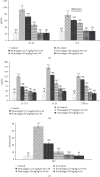Punicalagin Exerts Protective Effects against Ankylosing Spondylitis by Regulating NF- κ B-TH17/JAK2/STAT3 Signaling and Oxidative Stress
- PMID: 33029510
- PMCID: PMC7532417
- DOI: 10.1155/2020/4918239
Punicalagin Exerts Protective Effects against Ankylosing Spondylitis by Regulating NF- κ B-TH17/JAK2/STAT3 Signaling and Oxidative Stress
Abstract
Background: Ankylosing spondylitis (AS) is a chronic inflammatory disease characterized by sacroiliitis and spinal rigidity of the axial joints. The role of oxidative stress and increased proinflammatory cytokines is well documented in AS pathogenesis. Punicalagin (2,3-hexahydroxydiphenoyl-gallagyl-D-glucose), an ellagitannin widely present in pomegranates, is found to exhibit potent anti-inflammatory, antiproliferative, and antioxidative effects. The present study was undertaken to investigate the effects of punicalagin in a rodent model of AS.
Methods: BALB/c mice induced spondylitis were sacrificed 24 h after the last injection of proteoglycan extract. Histological scoring was done to assess the degree of the disease. The expression of JAK2/STAT3 proteins and proteins of the nuclear factor-κB (NF-κB) pathway was determined by immunoblotting. Serum levels of inflammatory mediators-TNF-α, IL-1β, IL-6, IL-17A, and IL-23-were assessed. Levels of lipid peroxidation and reactive oxygen species (ROS) were quantified. Antioxidant status as a measure of activities of antioxidant enzymes-catalase (CAT), glutathione peroxidase (GPx), and superoxide dismutase (SOD)-was determined.
Results: Punicalagin effectively improved antioxidant status and decreased lipid peroxidation, ROS production, and serum levels of inflammatory mediators. NF-κB pathway and JAK2/STAT3 signaling were significantly (p < 0.05) downregulated. Punicalagin effectively regulated the production of cytokines by the Th17 cells and the IL-17A/IL-23 axis.
Conclusion: The observations suggest that punicalagin exerts a protective role in AS via reducing oxidative stress and regulating NF-κB/TH17/JAK2/STAT3 signal. Punicalagin thus could be explored further as a potent candidate compound in the treatment of AS.
Copyright © 2020 Xinzhe Feng et al.
Conflict of interest statement
The authors declare there is no conflict of interest.
Figures







Similar articles
-
Xinfeng capsule improves pulmonary function in ankylosing spondylitis patients via NF-ΚB-iNOS-NO signaling pathway.J Tradit Chin Med. 2014 Dec;34(6):657-65. doi: 10.1016/s0254-6272(15)30079-0. J Tradit Chin Med. 2014. PMID: 25618969 Clinical Trial.
-
Ilex asprella aqueous extracts exert in vivo anti-inflammatory effects by regulating the NF-κB, JAK2/STAT3, and MAPK signaling pathways.J Ethnopharmacol. 2018 Oct 28;225:234-243. doi: 10.1016/j.jep.2018.06.037. Epub 2018 Jul 4. J Ethnopharmacol. 2018. PMID: 29981433
-
Oral administration of punicalagin attenuates imiquimod-induced psoriasis by reducing ROS generation and inflammation via MAPK/ERK and NF-κB signaling pathways.Phytother Res. 2024 Feb;38(2):713-726. doi: 10.1002/ptr.8071. Epub 2023 Nov 27. Phytother Res. 2024. PMID: 38009260
-
Antioxidant and anti-inflammatory effects of zinc. Zinc-dependent NF-κB signaling.Inflammopharmacology. 2017 Feb;25(1):11-24. doi: 10.1007/s10787-017-0309-4. Epub 2017 Jan 12. Inflammopharmacology. 2017. PMID: 28083748 Free PMC article. Review.
-
Multifaceted Neuroprotective Role of Punicalagin: A Review.Neurochem Res. 2024 Jun;49(6):1427-1436. doi: 10.1007/s11064-023-04081-w. Epub 2023 Dec 12. Neurochem Res. 2024. PMID: 38085406 Review.
Cited by
-
Bone marrow mesenchymal stem cells-derived exosomes suppress miRNA-5189-3p to increase fibroblast-like synoviocyte apoptosis via the BATF2/JAK2/STAT3 signaling pathway.Bioengineered. 2022 Mar;13(3):6767-6780. doi: 10.1080/21655979.2022.2045844. Bioengineered. 2022. PMID: 35246006 Free PMC article.
-
Decoding ferroptosis: transforming orthopedic disease management.Front Pharmacol. 2024 Dec 6;15:1509172. doi: 10.3389/fphar.2024.1509172. eCollection 2024. Front Pharmacol. 2024. PMID: 39712490 Free PMC article. Review.
-
[Advances in the Application of Nanozymes in Joint Disease Therapy].Sichuan Da Xue Xue Bao Yi Xue Ban. 2024 Jul 20;55(4):800-806. doi: 10.12182/20240760105. Sichuan Da Xue Xue Bao Yi Xue Ban. 2024. PMID: 39170029 Free PMC article. Review. Chinese.
-
No evidence of a genetic causal relationship between ankylosing spondylitis and iron homeostasis: A two-sample Mendelian randomization study.Front Nutr. 2023 Mar 23;10:1047640. doi: 10.3389/fnut.2023.1047640. eCollection 2023. Front Nutr. 2023. PMID: 37032771 Free PMC article.
-
Environmental and Genetic Determinants of Ankylosing Spondylitis.Int J Mol Sci. 2024 Jul 17;25(14):7814. doi: 10.3390/ijms25147814. Int J Mol Sci. 2024. PMID: 39063056 Free PMC article. Review.
References
MeSH terms
Substances
LinkOut - more resources
Full Text Sources
Medical
Research Materials
Miscellaneous

